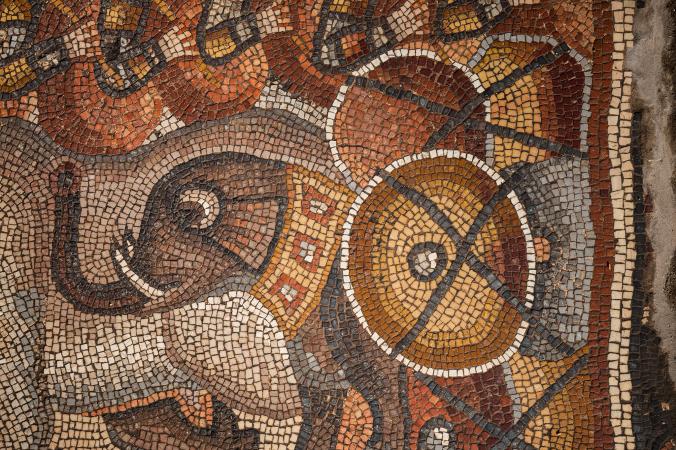Stunning mosaics that may depict Alexander the Great meeting a Jewish priest have been unearthed in Israel.
The artwork was uncovered in the east aisle of a fifth-century synagogue in the ancient Jewish village of Huqoq.
The scene is the first non-biblical story to be found in an ancient synagogue.
A team of archaeologists led by Professor Jodi Magness, of the University of North Carolina at Chapel Hill came across the intriguing scene, crafted from tiny pieces of mosaic.
The floor mosaic includes three horizontal strips containing human and animal figures, such as elephants.
The largest top strip contains the scene showing a meeting between two men, who perhaps represent the legendary warrior and a Jewish high priest.
In the scene, a bearded soldier wearing battle dress and a purple cloak leads a bull by the horns, followed by other soldiers and elephants with shields tied to their sides.
He is meeting with a grey-haired, bearded elderly man wearing a ceremonial white tunic and mantle, accompanied by young men with sheathed swords, also in ceremonial clothes.
 Professor Magness said the identification of the figures in this mosaic is unclear because there are no stories in the Hebrew Bible involving elephants.
Professor Magness said the identification of the figures in this mosaic is unclear because there are no stories in the Hebrew Bible involving elephants.
‘Battle elephants were associated with Greek armies beginning with Alexander the Great, so this might be a depiction of a Jewish legend about the meeting between Alexander and the Jewish high priest,’ she said.
‘Different versions of this story appear in the writings of Flavius Josephus and in rabbinic literature.’
The Huqoq excavations, which also involved a team from the Israel Antiquities Authority, began in 2012 when the first mosaics were found at the site, including an image of Samson.
This summer, more of the floor has been uncovered, including a dedicatory inscription, figures, animals and mythological creatures arranged symmetrically around it.
These include winged cupids holding roundels with theatre masks, muscular male figures wearing trousers who support a garland, a rooster, and male and female faces in a wreath encircling the inscription.
Cupids, called putti and masks are associated with the god Dionysos or Bacchus, who was the Greco-Roman god of wine and theatre performances, Professor Magness explained.
She said: ‘The images in these mosaics – as well as their high level of artistic quality – and the columns painted with vegetal motifs have never been found in any other ancient synagogue.
‘These are unique discoveries’
This summer’s excavations also brought to light columns inside the synagogue covered with plaster and painted ivy leaf designs.
In 2012, a mosaic showing Samson and the foxes, as described in the book of Judges was discovered in the synagogue’s east aisle.
The next summer, a second mosaic showing Samson carrying the gate of Gaza on his shoulders was found.
‘It is not clear if there is a thematic connection between the Samson scenes and the other mosaics in the east aisle,’ Professor Magness added.
The mosaics have been removed from the site for conservation, and the excavated areas have been back-filled.
More excavations are planned for next summer.